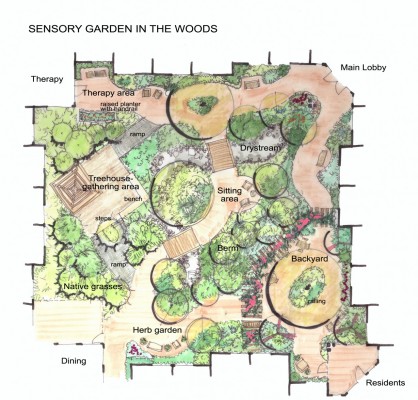The goal of the courtyard gardens is to create environments where residents and staff feel that they are truly living and working in park and homelike settings rather than institutional environments. The intergenerational elements planned for the gardens support family visits and encourage meaningful interactions between multiple generations.
Taking into account site and existing building conditions, the courtyard design concept of a sensory garden in the woods contrasts with interior environments and connects to the natural setting that surrounds the center. The sensory garden in the woods will evoke the sights, sounds, smells, and textures one finds in a forest. It will also offer opportunities in a natural outdoor setting to nurture the underlying and more foundational sensory systems: proprioception, kinesthesia, vestibular and provide realistic settings for physical, occupational and speech therapy programs. While the concept of a sensory garden in the woods provides a unifying theme, it also allows specific design elements that integrate and support the indoor activities associated with each entrance: the residential area, therapy area, dining area and facility lobby. Each of these entries has an individual seasonal theme as a subtle identification for wayfinding indoors and out.
Gently curved paths wind through the entire Sensory Garden encouraging walking as well as providing an outdoor alternative to get from one part of the facility to another. While a continuous flat walk is provided to main destinations, alternate paths with ramps, stairs and a variety of surfaces provide opportunities for therapy, areas for additional exercise and areas to “get away”. The main path will be 8’ wide with curbs or other edging, allowing two wheeled mobility devices, wheelchairs or a wheelchair and a stroller to move in tandem. The side paths will be 6’ wide, offering a sense of intimacy.
Coming off the residential activities lounge, a “back yard” is defined by a vine covered trellis bordered by a curving berm planted with, among other things, herbs, for residents, family members, and visitors to touch and smell. This will be an ideal spot for barbeques, parties, chair yoga, card games and small concerts.
A working/therapy garden adjacent to the therapy clinic offers a unique opportunity to receive physical, occupational, and speech therapy outside. This garden increases the usable therapy space and includes many elements found in an indoor therapy clinic such as flexible and adjustable height table and chairs, a ramp, stairs with railings, pathways of different surfaces, curbs and curb cuts, parallel bars, varying height planters, hanging plants on pulleys, a vertical garden, and plantings that nurture the senses. A therapist/client team can choose to address ambulation and mobility training, upper and lower body strengthening and range of motion, fine and gross motor skills, instrumental activities of daily living and leisure skills, sensory re-education, and speech and language issues, while in the garden. Studio Sprout has found in post occupancy evaluations that therapy in the garden is more motivating, purposeful, meaningful, and fun.

